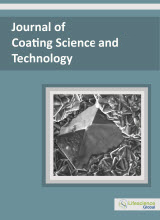jcst
Abstract : Preparation of Low Friction MoSex/nc-Mo Coatings Containing Spherical Mo Nanoparticles
|
|
|
Abstract: The possibility of preparation of nanocomposite coatings consisting of a solid lubricant matrix (MoSex) and nanocrystalline metal particles (nc-Mo) was demonstrated using pulsed laser deposition from synthesized target MoSe2.The particles had spherical shapes and their sizes were about 5 – 50 nm. The content of the nc-Mo nanoparticles in the MoSex/nc-Mo coatings was varied by changing the laser irradiation regimes and the conditions of expansion of the laser plume from the target to substrate. It was established that the tribological properties of the nanocomposite coatings MoSex/nc-Mo are depended on the concentration of nanoparticles in the bulk of the coatings as well as on the structure of the coating matrix. The MoSex/nc-Mo coating with increased crystalline order of matrix obtained on a steel substrate reduced the friction coefficient to ~0.04 during steel ball sliding in air of laboratory humidity. Probable mechanisms of nanoparticle formation were proposed and a role of these particles in the wear of the nanocomposite MoSex/nc-Mo coatings was discussed.
Keywords: Low friction coatings, Nanostructure, Nanoparticles, Coefficient of friction, Molybdenum diselenide. |
Abstract : Effect of Post Heated TiN Coating on Pitting Corrosion of Austenitic Stainless Steel
|
|
|
Abstract: This study used cathodic arc deposition technique to coat TiN film on 316L austenitic stainless steel, and then the coated specimens were heat-treated at the different temperatures. Observation of coating morphology and corrosion tests were conducted for exploring the effect of post-heating temperature on composition, microstructure, and corrosion behavior of the coatings. The results showed when the heating temperature was up to the range of 500-600 oC, a Ti-N-O mixed film consisting of the two TiO2 and TiN phases was formed on the outer layer. Particular, the film heated at 500 oC had a dense structure as well as homogeneous chemical composition. Such the result could effectively inhibit pitting corrosion of 316L stainless steel in 3.5 wt% NaCl and 10 vol% HCl solutions.
Keywords: Cathodic arc deposition, TiN film, 316L stainless steel, Post-heating, Pitting corrosion. |
Abstract : The Formation of Carbon Microcoils Having the Coil-Type Overall Geometry
|
|
|
Abstract: Carbon microcoils could be synthesized using a thermal chemical vapor deposition process in which C2H2/H2 is used as the source gas and SF6 as an additive gas. We investigated the formation of carbon microcoils as a function of reaction time to study the growth mechanism of coil-type carbon microcoils, particularly under long reaction time. After the first 5 min of the reaction, wave-like carbon nanocoils were formed along with carbon microcoils at certain positions on the sample. An increase in reaction time (60 min) led to the formation of double helix-type carbon microcoils. Further increase in the reaction time (120 min) led to the formation of twist-type carbon microcoils with occasional growth of the coil-type carbon microcoils on the sample. However, at the longest reaction time (180 min) investigated in this work, we observed a decrease in the density of the carbon microcoils. Based on these results, we determine the optimal reaction time for the growth of double helix-type carbon microcoils and suggest the growth mechanism of the coil-type carbon microcoils with a focus on long reaction time.
Keywords: Coil-type Carbon Microcoils, Growth Mechanism, Coil Geometry, Reaction Time, Thermal Chemical Vapor Deposition. |
Abstract : Growth of Si-Doped Polycrystalline Diamond Films on AlN Substrates by Microwave Plasma Chemical Vapor Deposition
|
|
|
Abstract: Microcrystalline diamond films doped with silicon have been grown on aluminum nitride substrates by a microwave plasma CVD. The doping has been performed via adding silane in various concentrations to CH4–H2 reaction gas mixture in course of the deposition process. The films produced at the substrate temperatures of 750 to 950°C have been characterized by SEM, AFM, Raman and photoluminescence (PL) spectroscopy to assess the effect of Si doping on the diamond structure. The doped films showed bright photoluminescence of silicon-vacancy (SiV) color centers at 738 nm wavelength as well as noticeable side band at 723 nm. The optimum doping condition (SiH4/CH4 ≈ 0.6%), that maximize the SiV PL emission, was determined for the range of silane concentrations SiH4/CH4 (0.0 – 0.9%) explored. A further PL enhancement can be achieved by increase in the substrate temperature. The applied in situ doping from gas phase is shown to be an easy and effective method to incorporate Si in diamond in a controllable way. Keywords: Diamond film, microwave plasma CVD, aluminum nitride, doping, silane, silicon-vacancy color center, photoluminescence, Raman spectroscopy. |























